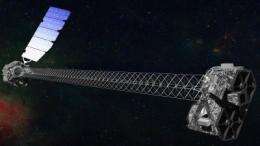This is an artist's rendering of NuSTAR. NuSTAR is the first telescope capable of focusing high-energy X-rays. It will also map supernova explosions and microflares on the surface of the sun. Credit: NASA/JPL-Caltech
When NASA launches a new telescope this Wednesday that will look at black holes in ways never seen before, Georgia Tech astrophysicist David Ballantyne will be more than a curious bystander. He helped plan the mission.
Ballantyne, one of the Institute's black hole experts, is on the science team of NASA's Nuclear Spectroscopic Telescope Array (NuSTAR), which is scheduled for launch Wednesday morning. He's one of a handful of people who decided where the high-energy X-ray telescope will point while in orbit. NuSTAR's technology will allow it to image areas of the universe in never-before-seen ways. Ballantyne will be among the first scientists to see the images and examine the data when it becomes available this later this summer.
"NuSTAR will provide a window to the murky world of black holes," said Ballantyne, an assistant professor in the School of Physics. "The high-energy X-ray technology will allow us to see black holes that are buried deep inside their galaxies, hidden behind thick clouds of dust and gas. The goal is to unmask these black holes, study their host galaxies, and figure out how the black holes affect galaxy formation and evolution."
Ballantyne has worked on the project, which is overseen by Fiona Harrison, a professor at the California Institute of Technology, since 2007. He and his peers have plotted three areas in the sky to survey, the largest of which spans approximately five full moons. Together, the surveys will uncover about 500 black holes, some of which have never been detected by any other telescope.
Seeing more means learning more, according to Ballantyne. He compares the study of black holes with learning about mankind.
"If you knew nothing about humans and looked at one person, you would quickly discover that we have two eyes, a nose and a mouth," said Ballantyne. "But the deeper knowledge – traits such as aging, cultures – is only discovered by looking at a wide range of people. The more black holes we discover and study, the more we will understand about their roles in the cosmos."
NuSTAR is the first telescope capable of focusing high-energy X-rays. It will also map supernova explosions and microflares on the surface of the sun. It is the first American high-energy telescope launched since 2008 and the last one for the foreseeable future. There are no other planned projects.
NuSTAR will lift off aboard an airplane in the South Pacific. The plane will then launch a Pegasus rocket, which will carry the telescope into orbit. Images and data should be available for Ballantyne and his colleagues about a month after liftoff. Selected images and science stories will be made available for the public throughout the mission.
Provided by Georgia Institute of Technology
























